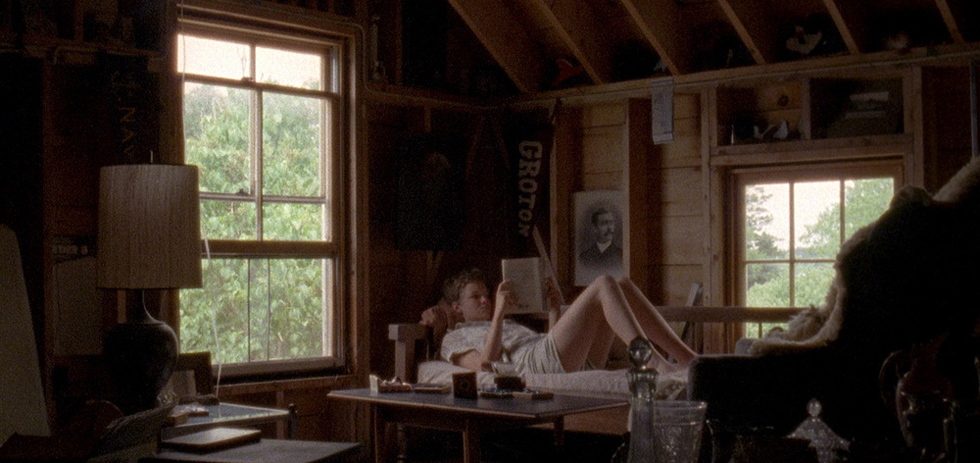
Using genre trappings as a vehicle for the introspection of characters isn’t a new approach in independent cinema, the cultural cache of science fiction often enough to allow minimalist, dialogue-heavy features to pass off as fully formed. The recent film Coherence essentially embodies this notion, using time travel and the gradual complexities of that plot system to mask over a somewhat unconvincing screenplay. For the Plasma, the debut feature of Brooklyn-based filmmakers Bingham Bryant and Kyle Molzan, initially appears to be heading in this vein. Set by the seaside in picturesque Maine, the film’s primary exposition is clunkily delivered in front of a bay of screens; it involves the stock market, patterns of movement, and forest fire awareness, Pi by way of Moonrise Kingdom. What sees Plasma veer away from the expectations of using genre as a crutch is its tone of wavering self-seriousness; the sci-fi tinted premise fades away in favour of striking images and enticing yet confusing character development. In that sense, then, the film amounts to something vaguely unclassifiable yet undoubtedly impressive.
The two women at the heart of this narrative are Helen (Rosalie Lowe, last seen in Desiree Akhavan’s Appropriate Behavior), who has spent a few months monitoring the likelihood of a forest fire from the Porter House in Maine, and Charlie (Anabelle LeMieux), Helen’s friend from school who has come to help out amidst her general aimlessness and in need of a break from her boyfriend. The relationship of the two women, now centred around an increasingly undefined power dynamic, slowly unravels in spite of each of their initial intentions. Charlie, sent into the forest to check on the trees, finds solace in her absence from Helen, whilst Helen finds her blissful ignorance surrounding her job’s true intentions threatened by an outsider.
The plot itself is less a compelling journey than a means through which to arrive at a series of wonderful visual moments that underline Bingham and Molzan’s thematic concerns. The cinematography, courtesy of Christopher Messina, is one of the film’s greatest strengths, the warm 16mm film vividly captures the natural scenery, which is framed in 4:3. His close-ups on faces call to mind Sean Price Williams’ work in Listen Up Philip and the willingness to use the camera as a means of punchline (sudden jerks away from a placid scene were especially amusing) means the viewer is constantly kept on their toes throughout the mostly patient narrative. The way technology is visually represented is likewise engaging, the room of light and screens giving way to a focus on the physical deconstruction of the notion of frames and perspective, as well as the concluding idea that focus and insight isn’t tethered to technological engagement.
As the camera feed of trees is to Charlie, so too is For the Plasma to the viewer; instructed to look for patterns, lines, shapes, meanings in a seemingly abstract and inexact image we find ourselves compensating for our lack of certainty with gleeful self-deception. It’s perhaps the cleverest narrative trick Bryant and Molzan pull, having the viewer enrapt in their own interpretation of the film’s narrative and meaning. There’s enough to work with on a thematic level, the bare bones plot touching on isolation, technology, and friendship, whilst Keichii Suzuki’s superb electronic score maintains a throughline of restrained joviality, almost an optimistic variation on the deceptively simple Gone Girl soundtrack.
Another abstraction is that the acting throughout seems intentionally stilted, Helen and Charlie’s voices are often dubbed; the juxtaposition with the carefully crafted visuals is, at first, quite jarring. At all times the dialogue is crisp and clear, even when the characters are at differing distances. It’s (presumably) not laziness on the part of the filmmakers, though, as the vocal dubbing manages to form part of this tonal abstraction, reinforcing the inability to truly be organic in a technological world.
Whilst the film’s logic and meaning isn’t entirely made clear to the viewer, the direction is remarkably assured; the visual playfulness on show never undercuts tone and is, in fact, consistently refreshing. Andrew Bujalski’s Computer Chess is oft-cited as a similar retro-oriented absurd comedy, but closer reference points might by Land Ho! (stunning visuals and score place tone over plot) and The One I Love (simple rule-based worldbuilding and acting two-hander). Again, though, For the Plasma is wholly its own beast, drawing as much from Japanese literature and music as the pastoral American landscape it inhabits. This enigmatic concoction of influences and ideas will almost certainly see it linger on in your memory.
For the Plasma has its Australian premiere on July 9th at Grey Gardens Projects in Fitzroy. You can purchase tickets for the screening, or find out more about the new cinema here.
Around the Staff
| Luke Goodsell |
